Wayanad district
| Wayanad district വയനാട് ജില്ല | |
|---|---|
| District | |
|
Wayanad scenery on NH 212 Kozhikode-Kollegal | |
 Location (Marked Black) in Kerala, India | |
| Coordinates: 11°36′18″N 76°04′59″E / 11.605°N 76.083°ECoordinates: 11°36′18″N 76°04′59″E / 11.605°N 76.083°E | |
| Country |
|
| State | Kerala |
| Headquarters | Kalpetta |
| Government | |
| • Member of Parliament | M I Shanavas |
| • District Collector | B S Thirumeni IAS |
| • District Panchayat President | Ushakumari |
| • District M.L.A's |
Sulthan Bathery : I.C Balakrishnan Kalpetta:C K Saseendran Mananthavady : O.R Kelu |
| Area | |
| • Total | 2,131 km2 (823 sq mi) |
| Population (2011) | |
| • Total | 816,558 |
| • Density | 380/km2 (990/sq mi) |
| Languages | |
| • Official | Malayalam, English |
| Time zone | IST (UTC+5:30) |
| ISO 3166 code | IN-KL |
| Vehicle registration | KL-12, KL-72, KL-73 |
| Website |
www |
Wayanad District is a district in the north-east of Kerala state, India with headquarters at the town of Kalpetta. The district was formed on 1 November 1980 as the 12th district in Kerala by carving out areas from Kozhikode and Kannur districts. The district is 3.79% urbanised, with three municipal towns Kalpetta, Mananthavady and Sulthan Bathery.
Location
Wayanad district is in the southern tip of the Deccan Plateau. Part of the Western Ghats is in the district. In the centre of the district hills are lower in height while the northern area has high hills. The eastern area is flat and open.
Etymology
The region was known as Mayakshetra (Maya's land) in the earliest records. Mayakshetra evolved into Mayanad and finally to Wayanad.[1] The Folk etymology of the word says it is a combination of Vayal (paddy field) and Naad (land), making it 'The Land of Paddy Fields'. There are many indigenous tribals in this area.[2] It is set high on the Western Ghats with altitudes ranging from 700 to 2100 m.[3][4]
History
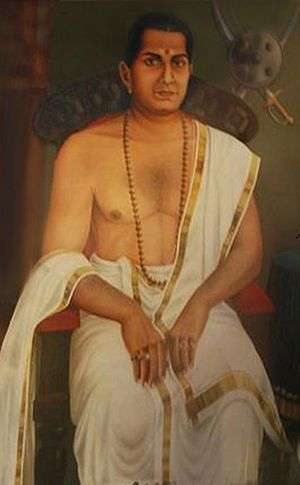
According to archaeological evidence, the Wayanad forests have been inhabited for more than 3,000 years. Historians are of the view that human settlement existed in these parts for at least ten centuries before Christ. Much evidence of New Stone Age civilisation can be seen in the hills throughout the present day Wayanad district. Recorded history of this district is available from the 18th century. In ancient times, this land was ruled by the Rajas of the Veda tribe.[5]
The Kutumbiyas:
The two caves of Ampukuthimala (Edakal Caves) in Sulthan Bathery, with pictures on their walls and pictorial writings, speak volumes of a bygone civilisation. At the foot of the Edakal Male (hill) caves, Kannada inscriptions belonging to Kutumbiya clan of Mysore dating to c. 500 CE were discovered which read - 'Palapulitaanamtakaari', 'Sri Vishnu Varma Kutumbiya Kulavardhanasya li..it..a..'. As per Hultzch, an epigraphist from the department of epigraphy, Madras, it speaks of the glorious descendant of Kutumbiya clan, Kannada chieftain, Vishnu Varma, as one who killed many tigers.[6][7][8]
The Gangas:
The recorded history of this district exists only from the 10th century onward. In 930 AD, emperor Ereyappa of Ganga Dynasty led his troops to the south west of Mysore - an invasion to the prosperous kingdom he had heard of from traders and Jain monks. Mission accomplished and he called the conquered kingdom ‘Bayalnad’ meaning the land of swamps. After Ereyappa, his sons Rachamalla and Battunga (or Butuga) fought each other for the new kingdom of their father’s legacy. Rachamalla was killed and Battunga became the undisputed ruler of Bayalnad.
The Kadmabas:
In the 11th century AD, Gangas were dethroned from Bayalnad by Kadamba dynasty[9] of North Canara.[10] Wayanad was at that time divided into two portions - Bira Bayalnad and Chagi Bayalnad. One of the Mysore inscriptions (alluding perhaps to the treacherous beauty of the country, which attracted the stranger and then laid him low with malaria) says 'an adulteress with black waving curls, as adulteress with full-moon face, an adulteress with endless side-glances, an adulteress with adorned slim figure was this storeyed mansion, the double Bayalnad'.[11] Kadamba Bayalnad emerged as a rule in the 11th century under their chief Raviyammarasa with Kirttipura in Punnad their capital. Kanthirava (1090 CE) was described as ruling Chagi-Bayalnad. Iravi-Challamma (1108 CE) was the ruler of Bira-Bayalnad.[12]
The Hoysalas:
In 1104 AD Vishnuvardhana of Hoysala invaded Bayalnad followed by Vijayanagara dynasty in the 14th century. A Kadamba king, Mukkanna-Kadamba ruled Bayal-nad in and around 1138 CE.[13]
The Vijayanagara empire:
A feudatory chieftain of Sangama dynasty of Vijaynagar, Immadi Kadamba Raya Vodeyayya of Bayalnad Kadambas, is said to have ruled Bayalnad.[12]
The Mysore Wodeyars and the Sultans:
In 1610 AD Udaiyar Raja Wadiyar of Mysore drove out Vijayanagara General and became the ruler of Bayalnad and the Nilgiris. Bayalnad is the present Wayanad. When Wayanad was under Hyder Ali’s rule, the ghat road from Vythiri to Thamarassery invented.[14] Then the British rulers developed this route to Carter road.[15] When Wayanad was under Tipu Sultan's rule British invasion started. Tussle and turbulent times followed. The British claimed Wayanad under the 1792 treaty of Srirangapatna citing it was part of Malabar. Tipu Sultan went in appeal before the Governor General. Considering his arguments, relying on the successive Karnataka rule for centuries in Wayanad and its geographical detachment from Malabar, in 1798, Governor General Lord Mornington declared by proclamation[16] that Wayanad had not been ceded to the East India Company by the treaty of 1792. Consequently, the British troops withdrew from Wayanad conceding to Tipu’s rule. In 1799, after the fall of Sultan, the British handed over Wayanad by the treaty of 1799 to the Raja of Mysore. But by a supplementary treaty dated 29 December 1803 the East India Company repossessed Wayanad and thereafter administrated by Col. Arthur Wellesley from Srirangapatna and North Wayanad came under the rule of the Pazhassi Raja dynasty of ancient Kottayam.
Pazhashi Raja:
In later days, Wayanad came under the rule of the Pazhassi Rajahs of Kottayam royal dynasty. When Hyder Ali became the ruler of Mysore, he invaded Wayanad and brought it under his sway. In the days of Tipu, Wayanad was restored to the Kottayam royal dynasty. But Tipu handed over the entire Malabar region to the British, after the Srirangapattana truce, he made with them. This was followed by fierce and internecine encounters between the British and Kerala Varma Pazhassi Rajah of Kottayam. When the Rajah was driven to the wilderness of Wayanad, he organised the war-like Kurichiya tribals into a sort of people's militia and engaged the British in several guerrilla type encounters.
British Rule:
In the end, the British could get only the dead body of the Rajah, who killed himself somewhere in the interior of the forest. Thus, Wayanad fell into the hands of the British and with it came a new turn in the home of this area. The British authorities opened up the plateau to the cultivation of tea and other cash crops by constructing roads across the dangerous slopes of Wayanad, to Kozhikode and Thalassery. Later, they extended these new roads to the cities of Mysore and Ooty through Gudalur. Settlers emigrated from all parts of Kerala and the fecund lands proved a veritable goldmine with incredible yields of cash crops. Agriculture Cultivation started broadly after 1900 A.D onwards. Wayanad eventually became part of Kerala despite its geographical delimitations and political descent in 1956 on State’s reorganisation. Even now there is a considerable Kannada speaking population and the reminiscence of centuries old Karnataka rule is omnipresent in Wayanad. When the State of Kerala came into being in November 1956, Wayanad was part of Kannur district. Later, south Wayanad was added to Kozhikode district. To fulfil the aspirations of the people of Wayanad for development, North Wayanad and South Wayanad were carved out and joined together to form the present district of Wayanad. This district came into being on 1 November 1980 as one the twelve districts of Kerala,[17] consisting of three taluks; Vythiri, Mananthavady, and Sulthan Bathery.
Cities and towns
- Kalpetta, 31,580 people. Capital of the district
- Mananthavady, 37,836 people
- Pulpally, 30,035 people
- Sultan Bathery, 27,473 people
- Padinharethara, 15,174 people
- Panamaram, 11,651 people
- Meenangadi
- Ambalavayal
- Meppadi
- vythiri
Tourist attractions
- Banasura Sagar Dam
- Pookode Lake
- Karapuzha Dam
- Chembra Peak, the highest peak in Wayanad, at 2,050 m above sea level.
- Wayanad Adventure Camp, Karalad Lake
- Phantom Rock
- Thirunelly Temple
- Valliyoorkkavu Temple
- Seetha Lava Kusha Temple
- Soochippara waterfall
Meppadi Hills
Meppadi is the most picteresque part of Wayanad district. The major attractions in this regions are Chembra peak, Soochippara waterfalls, Chooralmala Road and the Mango Orange village.
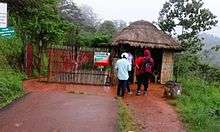 Soochippara
Soochippara- Chembra
.jpg) Chooralmala
Chooralmala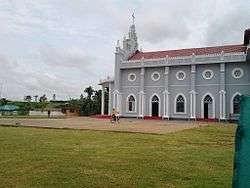 Mooppanad
Mooppanad
Geography
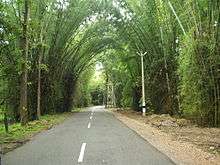


Wayanad district stands on the southern tip of the Deccan plateau and includes part of the Western Ghats. Quite a large area of the district is covered by forest but the continued and indiscriminate exploitation of the natural resources point towards an imminent[18] environmental crisis. It has a large amount of dry and moist deciduous forest. Wayanad is home to endangered species.
The Kabini River, one of the three east flowing rivers of Kerala, is an important tributary of the Kaveri River. Almost the entire Wayanad district is drained by Kabini and its three tributaries, the Panamaram, Mananthavady, and Kalindy rivers. The Banasura Sagar Dam is built on one of the tributaries of the Kabini River.
Economy
In 2006, the Ministry of Panchayati Raj named Wayanad one of the country's 250 most backward districts (out of a total of 640).[19] It is one of the two districts in Kerala currently receiving funds from the Backward Regions Grant Fund Programme (BRGF).[19]
Demographics
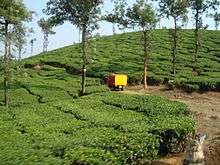
It is the least populous district in Kerala.[20] Unlike all other 13 districts of Kerala, in Wayanad district, there is no town or village named same as the district (i.e., there is no "Wayanad town"). According to the 2011 census Wayanad district had a population of 816,558,[20] roughly equal to the nation of Comoros.[21] This gives it a ranking of 482nd in India (out of a total of 640).[20] The district has a population density of 383 inhabitants per square kilometre (990/sq mi).[20] Its population growth rate over the decade 2001–2011 was 4.6%.[20] Wayanad has a sex ratio of 1035 females for every 1000 males,[20] and a literacy rate of 89.32%.[20] Paniyas, Uraali Kurumas, and Kurichiyans comprise the tribes in Wayanad. Badagas are present in 21 hamlets spread across Wayanad.[22] The entire Wayanad region fell under the Kannada speaking area as per the linguistic survey and history of Colonel Wilks.[23]
Administration
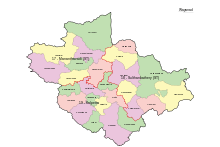
- District Headquarters: Kalpetta. District Collector, District Police Chief and District Judge are based at Kalpetta.
- No. of Taluks: 3
- No. of state Assembly Legislators: 3[24]
- *Kalpetta - Current MLA is Mr. C. K. Saseendran
- *Sulthan Bathery - Current MLA is Mr. I.C. Balakrishnan
- *Mananthavady - Current MLA is Mr. O. R. Kelu
- Lok Sabha Representation: 1
- *Wayanad Lok Sabha constituency - Current Member of Parliament is Mr. M. I. Shanavas.
Access
The Kozhikode–Mysore National Highway 212 (NH 212) passes through Wayanad district. En route to Mysore on NH 212, past Wayanad district boundary, which is also the Kerala state boundary, NH 212 passes through Bandipur National Park. There is a night traffic ban imposed on this stretch since 2009.[25] The alternate road to take is, leave NH 212 at Kalpetta and proceed to Mysore through Mananthavady, Kutta, Gonikoppal, and Hunsur. The nearest railway stations are Calicut and Mysore. Kozhikode International Airport at Karipur is the nearest airport, 95 km from Kalpetta. Kannur International Airport, under construction at Mattannur is at a distance of 70 km from Mananthavady.
Image gallery
 300 year old Panamaram Srambia
300 year old Panamaram Srambia Punchavayal Bull Statue
Punchavayal Bull Statue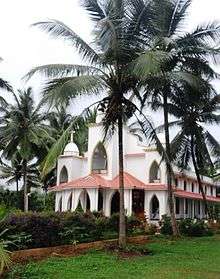 Padre Pio church
Padre Pio church Aram Mile Dargah
Aram Mile Dargah
See also
- Kodagu
- Malabar
- List of Temples in Wayanad District
- List of educational institutions in Wayanad district
References
- ↑ Wayanad Rekhakal by O. K. Johnny, Mathrubhumi Books
- ↑ "Kerala Tourism".
- ↑ "Wayanad".
- ↑ "Wayanad Map" (PDF). 2008. Retrieved 7 September 2008.
- ↑ http://wayanad.nic.in/history.htm
- ↑ Aiyappan, A. (1992). The Paniyas: An Ex-slave Tribe of South India. The University of Michigan: Institute of Social Research and Applied Anthropology. pp. 20, 28–29, 80.
- ↑ Peter, Jenee (24 October 2015). "Multidisciplinary Documentation of Rock Art and its Allied Subjects in Kerala" (PDF). INDIRA GANDHI NATIONAL CENTRE FOR THE ARTS. IGNCA. p. 2.
- ↑ Mathpal, Yashodhar (1998). Rock Art In Kerala. The University of Michigan: Indira Gandhi National Centre for the Arts. p. 28. ISBN 9788173051302.
- ↑ The Kadamba Kula, A History of Ancient and Mediaeval Karnataka, By George M. Moraes, BX Furtado & sons, Bombay, 1931.
- ↑ "The Kadamba Kula". Internet Archive.
- ↑ Francis, Walter (1908). Madras District Gazetteers: The Nilgiris. 1. New Delhi: Asian Educational Services. pp. 90–94, 102–105. ISBN 978-81-2060-546-6.
- 1 2 Nimkar, Madhu (18 September 2009). "Kingdom of Kadambas". History of India. Atom.
- ↑ Rice, B. Lewis (1902). Epigraphica Carnatica (PDF). Mangalore: Government of India. pp. 24, 28, 32.
- ↑ Madrass District Gazetteeers, The Nilgiris. By W. Francic. Madras 1908 Pages 90-104
- ↑ Report of the Administration of Mysore 1863-64. British Parliament Library
- ↑ Proclamation No:CLXXXLL, A. Collection of treaties and engagements, By W.Logan, Calicut 1879
- ↑ "Official Web Site of Wayanad District". ayanad.nic.in. Retrieved 2014-01-29.
- ↑ "ingentaconnect Consuming the Forest in an Environment of Crisis: Nature Tourism,...". ingentaconnect.com. Retrieved 2014-01-29.
- 1 2 Ministry of Panchayati Raj (8 September 2009). "A Note on the Backward Regions Grant Fund Programme" (PDF). National Institute of Rural Development. Retrieved 27 September 2011.
- 1 2 3 4 5 6 7 "District Census 2011". Census2011.co.in. 2011. Retrieved 30 September 2011.
- ↑ US Directorate of Intelligence. "Country Comparison: Population". Retrieved 1 October 2011.
Comoros 794,683 July 2011 est.
- ↑ Hockings, Paul; Pilot-Raichoor, Christiane (1992). A Badaga-English Dictionary. Walter de Gruyter. p. 514. ISBN 9783110126778.
- ↑ Imperial Gazetteer of India, v. 9, p. 301. DSAL. pp. p. 301.
- ↑ {{cite web
- | url =http://archive.eci.gov.in/se2001/background/S11/KL_Dist_PC_AC.pdf
- | format=PDF
- | title =Assembly Constituencies – Corresponding Districts and Parliamentary Constituencies
- | accessdate =18 October 2008
- | work =Kerala
- | publisher =Election Commission of India }}
- ↑ "Bandipur-road-to-be-closed-at-night". DNA India. Retrieved 2014-05-11.
External links
| Wikimedia Commons has media related to Wayanad district. |
| Wikivoyage has a travel guide for Wayanad District. |
 |
Kannur district | Kodagu district, Karnataka | Mysore district, Karnataka |  |
| |
Chamarajanagar district, Karnataka | |||
| ||||
| | ||||
| Kozhikode district | Malappuram district | Nilgiris district, Tamil Nadu |
